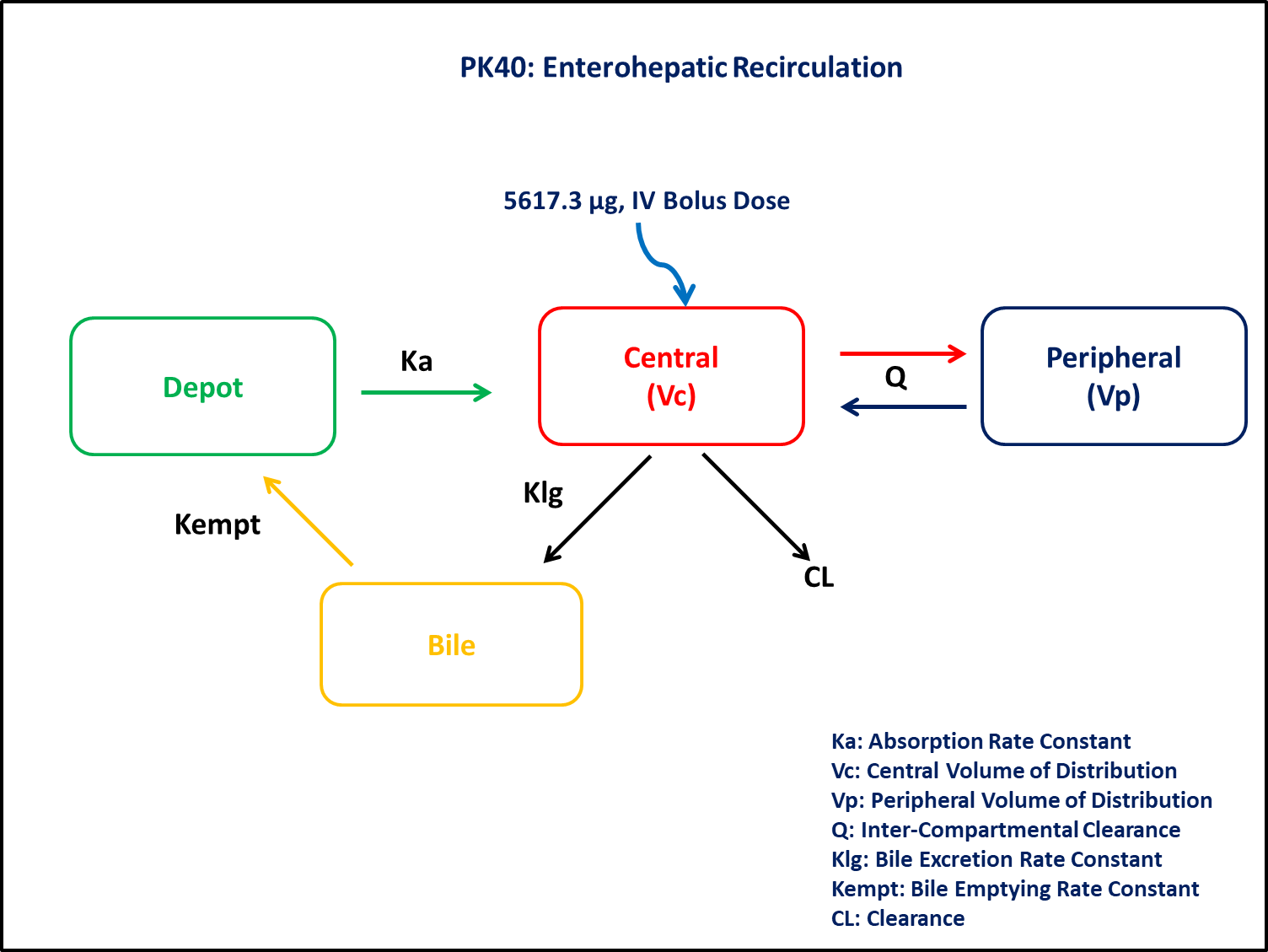using PumasUtilities
using Random
using Pumas
using CairoMakie
using AlgebraOfGraphics
using CSV
using DataFramesMeta
using Dates
PK40 - Multi-compartment model with Enterohepatic Recirculation after IV administration
1 Background
- Structural model - Enterohepatic Recirculation (EHS)
- Route of administration - IV bolus dose
- Dosage Regimen - 5617.3 μg IV bolus dose was administered and drug plasma concentration was measured for 36 hours
- Number of Subjects - 1

2 Learning Outcome
This exercise demonstrates IV bolus dose kinetics from a multi-compartment model with Enterohepatic Recirculation.
3 Objectives
To build a multi-compartment model with Enterohepatic Recirculation, simulate the model for a single subject given an IV bolus dose and subsequently perform a simulation for a population.
4 Libraries
Load the necessary libraries.
5 Model definition
Note the expression of the model parameters with helpful comments. The model is expressed with differential equations. Residual variability is a proportional error model.
It is a multi-compartment model with Enterohepatic Recirculation
pk_40 = @model begin
@metadata begin
desc = "Enterohepatic Recirculation Model"
timeu = u"hr"
end
@param begin
"""
Clearance (L/hr)
"""
tvcl ∈ RealDomain(lower = 0)
"""
Central Volume of Distribution (L)
"""
tvvc ∈ RealDomain(lower = 0)
"""
Peripheral Volume of Distribution (L)
"""
tvvp ∈ RealDomain(lower = 0)
"""
Intercompartmental Clearance (L/hr)
"""
tvQ ∈ RealDomain(lower = 0)
"""
Absorption rate Constant (hr⁻¹)
"""
tvka ∈ RealDomain(lower = 0)
"""
Bile Excretion rate constant (hr⁻¹)
"""
tvklg ∈ RealDomain(lower = 0)
"""
Bile emptying Interval (hr)
"""
tvτ ∈ RealDomain(lower = 0)
Ω ∈ PDiagDomain(7)
"""
Proportional RUV
"""
σ²_prop ∈ RealDomain(lower = 0)
end
@random begin
η ~ MvNormal(Ω)
end
@pre begin
Cl = tvcl * exp(η[1])
Vc = tvvc * exp(η[2])
Vp = tvvp * exp(η[3])
Q = tvQ * exp(η[4])
Ka = tvka * exp(η[5])
Klg = tvklg * exp(η[6])
τ = tvτ * exp(η[7])
Kempt = (t > 10 && t < (10 + τ)) * (1 / τ)
end
@dynamics begin
Central' =
Ka * Depot - (Cl / Vc) * Central + (Q / Vp) * Peripheral - (Q / Vc) * Central - Klg * Central
Peripheral' = (Q / Vc) * Central - (Q / Vp) * Peripheral
Bile' = Klg * Central - Bile * Kempt
Depot' = Bile * Kempt - Ka * Depot
end
@derived begin
cp = @. Central / Vc
"""
Observed Concentration (μg/L)
"""
dv ~ @. Normal(cp, sqrt(cp^2 * σ²_prop))
end
endPumasModel
Parameters: tvcl, tvvc, tvvp, tvQ, tvka, tvklg, tvτ, Ω, σ²_prop
Random effects: η
Covariates:
Dynamical system variables: Central, Peripheral, Bile, Depot
Dynamical system type: Nonlinear ODE
Derived: cp, dv
Observed: cp, dv6 Initial Estimates of Model Parameters
The model parameters for simulation are the following. Note that tv represents the typical value for parameters.
tvcl- Clearance (L/hr)tvvc- Central Volume of Distribution (L)tvvp- Peripheral Volume of Distribution (L)tvQ- Intercompartmental Clearance (L/hr)tvka- Absorption rate Constant (hr⁻¹)tvklg- Bile Excretion rate constant (hr⁻¹)tvτ- Typical Value bile emptying Interval (hr)Kempt- Bile Emptying rate constant (hr⁻¹)Ω- Between Subject Variabilityσ- Residual error
param = (
tvcl = 0.842102,
tvvc = 12.8201,
tvvp = 29.0867,
tvQ = 11.3699,
tvka = 3.01245,
tvklg = 0.609319,
tvτ = 2.79697,
Ω = Diagonal([0.1, 0.1, 0.1, 0.1, 0.1, 0.1, 0.1]),
σ²_prop = 0.5,
)7 Dosage Regimen
A 5617.3 μg IV bolus dose is administered at time 0 and drug plasma concentration was measured for 36 hours
ev1 = DosageRegimen(5617.3, time = 0, cmt = 1)| Row | time | cmt | amt | evid | ii | addl | rate | duration | ss | route |
|---|---|---|---|---|---|---|---|---|---|---|
| Float64 | Int64 | Float64 | Int8 | Float64 | Int64 | Float64 | Float64 | Int8 | NCA.Route | |
| 1 | 0.0 | 1 | 5617.3 | 1 | 0.0 | 0 | 0.0 | 0.0 | 0 | NullRoute |
8 Single-individual that receives the defined dose
sub1 = Subject(id = 1, events = ev1)Subject
ID: 1
Events: 19 Single-Subject Simulation
Simulate the plasma concentration after IV administration
Initialize the random number generator with a seed for reproducibility of the simulation.
Random.seed!(123)Define the timepoints at which concentration values will be simulated.
sim1 = simobs(pk_40, sub1, param, obstimes = 0:0.1:36)SimulatedObservations
Simulated variables: cp, dv
Time: 0.0:0.1:36.010 Visualize Results
@chain DataFrame(sim1) begin
dropmissing(:cp)
data(_) *
mapping(:time => "Time (hours)", :cp => "Concentration (μg/L)") *
visual(Lines; linewidth = 4)
draw(; figure = (; fontsize = 22), axis = (; xticks = 0:5:40))
end11 Population Simulation
We perform a population simulation with 50 participants.
This code demonstrates how to write the simulated concentrations to a comma separated file (.csv).
par = (
tvcl = 0.842102,
tvvc = 12.8201,
tvvp = 29.0867,
tvQ = 11.3699,
tvka = 3.01245,
tvklg = 0.609319,
tvτ = 2.79697,
Ω = Diagonal([0.012, 0.0423, 0.0342, 0.0465, 0.0129, 0.0278, 0.0532]),
σ²_prop = 0.0677818,
)
ev1 = DosageRegimen(5617.3, time = 0, cmt = 1)
pop = map(i -> Subject(id = i, events = ev1), 1:50)
Random.seed!(1234)
pop_sim = simobs(
pk_40,
pop,
par,
obstimes = [
0.03,
0.083,
0.15,
0.17,
0.33,
0.5,
0.67,
0.83,
1,
1.5,
2,
4,
6,
8,
10,
10.5,
11,
11.5,
12,
12.5,
13,
15,
16,
17,
18,
20,
24,
26,
28,
30,
32,
36,
],
)
pkdata_40_sim = DataFrame(pop_sim)
#CSV.write("pk_40_sim.csv", pkdata_40_sim)12 Conclusion
This tutorial showed how to build a multi-compartment model with Enterohepatic Recirculation and perform a single subject and a population simulation.